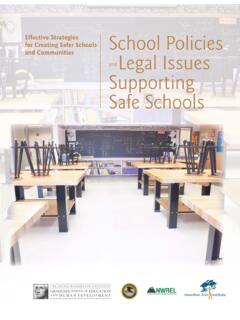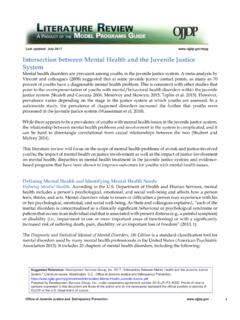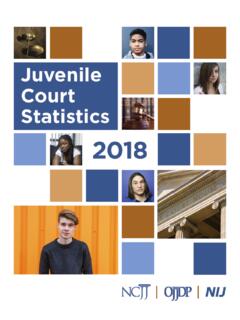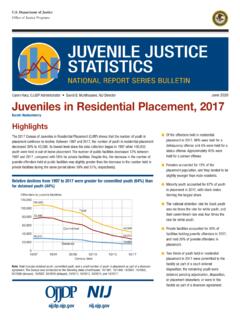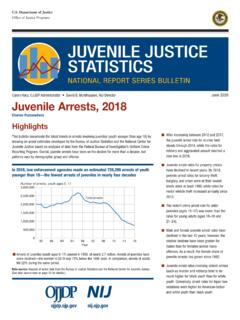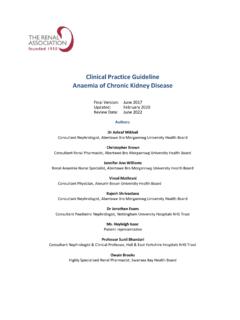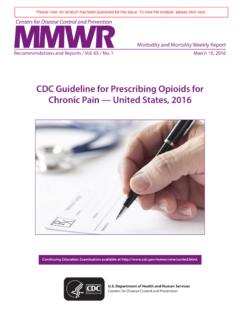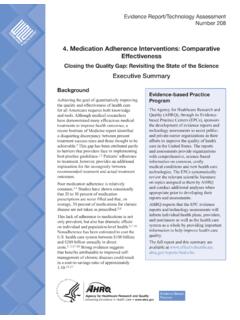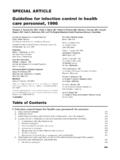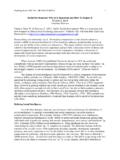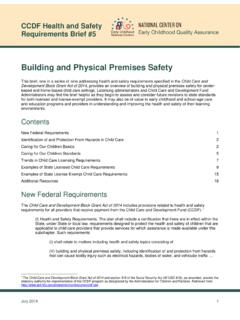Transcription of Commercial Sexual Exploitation of Children Sex Trafficking ...
1 Last updated: August 2014 Commercial Sexual Exploitation of Children and Sex Trafficking Commercial Sexual Exploitation of Children (CSEC) refers to a range of crimes and activities involving the Sexual abuse or Exploitation of a child for the financial benefit of any person or in exchange for anything of value (including monetary and non-monetary benefits) given or received by any person. (OJJDP ). There are no Federal, national estimates of the extent and prevalence of CSEC in the United States due to a variety of issues including general underreporting of the crime and the difficulties associated with identifying and measuring victims and perpetrators.
2 Academic efforts to quantify the extent of the problem have included estimates that range from a few thousand to millions (IOM and NRC 2013; Bryan 2014; The Polaris Project 2012). When estimates are presented, they often come with numerous qualifiers and caveats (IOM and NRC 2013). Commercial Sexual Exploitation manifests in numerous forms, such as sex Trafficking , prostitution, sex tourism, pornography, early marriage, performance in Sexual venues, and online or electronic transmission of Children engaged in Sexual activities (OJJDP ). Sex Trafficking is also a form of human Trafficking (President s Interagency Taskforce to Monitor and Combat Trafficking in Persons 2014, 5). Human Trafficking can appear in several other forms, including forced labor, bonded labor, involuntary domestic servitude, child soldier recruitment, and debt bondage among migrant laborers ( Department of State 2011).
3 Recent estimates by global organizations suggest that around 27 million people worldwide are current victims of human Trafficking (Williamson 2012). Sex Trafficking is most common in Europe, Central Asia, and the Americas (Greenbaum 2014). Governmental and nongovernmental organizations define human Trafficking as the Exploitation of another person through the use of fraud, coercion, or force. The Trafficking Victims Protection Act of 2000 (TVPA) states that any Commercial sex act if the person is under 18 years of age, regardless of whether any form of coercion is involved, is defined as human Trafficking ( Department of State 2011, 8). Therefore, if the victim is considered a minor, then force, fraud, or coercion do not need to be established; the sex act is automatically sex Trafficking .
4 A recent Department of Justice report found that 82 percent of suspected Trafficking incidents between 2008 and 2010 were classified as sex Trafficking . This included over 1,000 reported allegations of adult sex Trafficking and over 1,000 incidents of child sex Trafficking (Banks and Kyckkelhahn 2011). Similarly, other studies have found that as many as 79 percent of human Trafficking cases are identified as instances of Sexual Exploitation (van der Laan et al. 2011). A 2012 report by the United Nations Office on Drugs and Crime found that victims from 136 countries worldwide were trafficked in 118 countries, demonstrating the global impact and reach of human Trafficking (Greenbaum 2014). Suggested Reference: Development Services Group, Inc. 2014.
5 Commercial Sexual Exploitation of Children /Sex Trafficking . Literature review. Washington, : Office of Juvenile Justice and Delinquency Prevention. Prepared by Development Services Group, Inc., under cooperative agreement number 2013 JF FX K002. Points of view or opinions expressed in this document are those of the author and do not necessarily represent the official position or policies of OJJDP or the Department of of Juvenile Justice and Delinquency Prevention 1 Antitrafficking LegislationThe Trafficking Victims Protection Act (TVPA) a law enacted to end human Trafficking . It provides an evaluation tool that rates nations on their efforts and ability to end human Trafficking .
6 Through the Department of State, each country is assigned a tier that is used to measure how individual nations comply with antitrafficking policies (Goodey 2008). Tier 1 is given to nations that comply with antitrafficking polices, and Tier 3 is the lowest ranking, assigned to nations with the lowest level of compliance. Designation as a Tier 3 nation can have serious consequences and can lead to sanctions from the government, which affect nonhumanitarian and non-trade- related aid (Goodey 2008). Additionally, the TVPA sets a minimum standard for countries to follow as they strive to actively combat Trafficking through the use of a 3 Ps paradigm: Prevention of human Trafficking ; Protection of victims; and Prosecution of Trafficking offenders ( Department of State 2011; President s Interagency Taskforce to Monitor and Combat Trafficking in Persons 2014).
7 The prevention and prosecution elements of the 3 Ps approach are rooted in the victim-response model to human Trafficking . Responding to the needs of Trafficking victims is generally less complicated compared with trying to resolve the root causes of human Trafficking , which often include unequal economies or conflicts and war (Goodey 2008). The Congress has reauthorized TVPA four times. The most recent reauthorization, which was part of the Violence Against Women Reauthorization Act of 2013, includes a particular focus on sex Trafficking of minors (President s Interagency Taskforce to Monitor and Combat Trafficking in Persons 2014). These 3 Ps are also included in the Palermo Protocol, an anti- Trafficking law created by the United Nations, that resembles the TVPA.
8 The Palermo Protocol emphasizes effective action to prevent and combat Trafficking in [it] includes measures to prevent such Trafficking , to punish the traffickers, and to protect the victims of such Trafficking ( Department of State 2011). The protocol requires the prohibition and punishment of all human Trafficking crimes. A majority of nations, including the United States, have ratified and implemented the Palermo Protocol. Since the implementation of this protocol, the numbers of prosecutions and convictions for human Trafficking has steadily risen worldwide, with 6,017 prosecutions and 3,319 convictions in 2010, almost 2,000 more combined prosecutions and convictions than in 2008 ( Department of State 2011).
9 The Palermo Protocol and the TVPA are international examples of measures that can be used to combat Trafficking and legal precedents requiring state parties to act and be accountable for ending CSEC and Sex Trafficking . Characteristics of CSEC and Sex Trafficked Children Identifying victims of CSEC and sex Trafficking , can be difficult because of a general lack of public awareness about the issue; the reluctance of many exploited Children to identify themselves as victims; and extreme measures taken by exploiters to hide their victims and their crimes (Walker 2013; President s Interagency Taskforce to Monitor and Combat Trafficking in Persons 2014). On average, Children first fall victim to CSEC between ages 12 and 14 (Adams, Owens, and Small 2010; Greenbaum 2014).
10 Many youth CSE victims tend to come from vulnerable populations with a serious history of previous abuse. Some research suggests victims are now increasingly younger because exploiters are worried about contracting HIV or AIDS from victims (Adams, Owens, and Small 2010). Research on people who are trafficked shows that victims (juvenile and adult) come from all backgrounds, sexes, Office of Juvenile Justice and Delinquency Prevention 2 nations, and economic levels. In a 2011 report by the Bureau of Justice Statistics on the characteristics of suspected human Trafficking incidents, almost 95 percent of sex trafficked victims were female.
